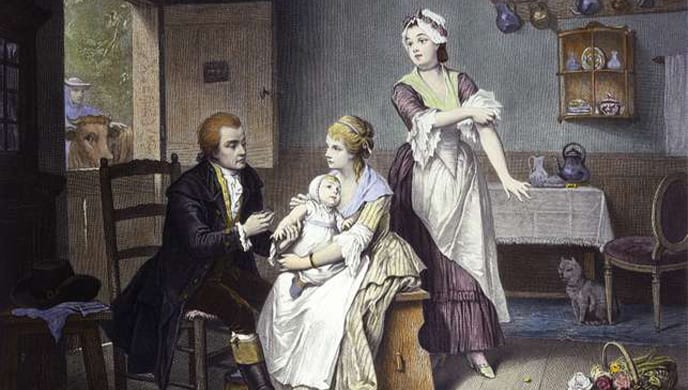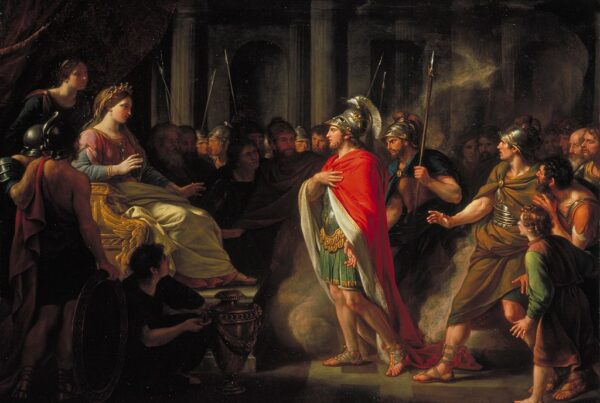Facing a pandemic with the Mozarts
By Bruce Lamott
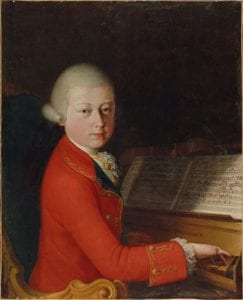
Portrait of Wolfgang Amadeus Mozart at the age of 13 in Verona, 1770
The multiple disappointments we have faced this spring during the pandemic shutdown—including the cancellation of Nic’s farewell performances of Leclair’s opera Scylla et Glaucus and our long-awaited trip to Versailles—bring to mind another pandemic, one that thwarted the travel plans and threatened the lives of the Mozart family: smallpox.
In the fall of 1767, the family of four—father Leopold, mother Anna Maria, sister Maria Anna (“Nannerl”), and Wolfgang—and a servant set out from Salzburg for Vienna, in the hopes of performing for, and perhaps being offered commissions or employment by Empress Maria Theresa and her son, Emperor Joseph II. Just the year before, the Mozarts had completed a three-and-a-half year Grand Tour featuring performances by the two Wunderkinder, but the window on their prodigy status of the siblings—Nannerl (16) and Wolfgang (almost 12)—was closing soon.
They could not have arrived at a worse time. When they arrived in mid-September, Vienna was festively anticipating the impending wedding of the beautiful sixteen-year-old Archduchess Maria Josepha, sister of Joseph II and Marie Antoinette (three of the ten of the Empress’ sixteen children who survived to adulthood), to King Ferdinand I of Naples. But by October 17, Leopold writes that “The Princess bride has become a bride of the Heavenly bridegroom.” The archduchess had succumbed to smallpox on the very day of her anticipated departure for Naples, plunging the court into six weeks of mourning and dashing Leopold’s hopes of being summoned to court. Within the week, young Wolfgang began an elegy for two sopranos (KV Anh.24a/43a) in an inexplicably cheerful F major.
Ach, was müßen wir erfahren!
Wie? Josepha lebt nicht mehr!
Sie gibt in den schönsten Jahren
Sich zum Todesopfer mehr.
Nicht die Glut der frohen Jugend,
Nicht die angestammte Tugend,
Der sie ganz gewidmet war,
Schützt sie vor der kalten Bahr’.
Oh, what we must know!
How? Josepha lives no more.
She gives herself to be death’s offering
In the most beautiful of years.
Neither the glow of happy youth,
Nor the ancestral virtue
To which she was wholly dedicated,
Protects her from the cold stretcher.
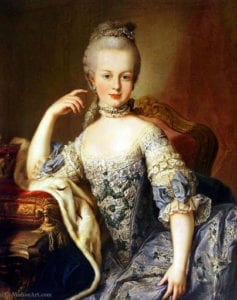
Archduchess Maria Josepha of Austria
You can hear performed at https://www.youtube.com/watch?v=u3UpsqN4ip0. (In a macabre twist, it’s also found as an instrumental in albums such as “Classical Lullabies for Sleeping Baby.”)
“The only subject of conversation in Vienna was the smallpox,” writes Leopold to his friend Hagenauer in Salzburg. “Of ten children whose names were put on the death register, nine had died of this disease.” When three of their landlord’s children became ill, Leopold moved out with Wolfgang to a friend’s house, leaving behind Nannerl and her mother with the servant.. (Because Nannerl bore a few pockmarks, they presumed that she had previously contracted the disease and recovered. They proved to be wrong.) Still hoping for a summons to the court, Leopold hesitated until he heard that the Archduchess Elizabeth too had fallen ill: “I could scarcely wait until the hour came when I could get my little Wolfgang out of Vienna (which was by this time thoroughly infected) and into a different atmosphere.”
By the time they arrived in Olomouc in Moravia (about 130 miles to the north, now in the Czech Republic), “I noticed that his head was warm , that his cheeks were hot and very red, but that his hands were as cold as ice. Moreover his pulse was not right. So we gave him some black powder (i.e., calomel, containing mercury) and put him to bed.” The next evening, “he began to rave, and all night long and during the morning of the 28th (October) he was delirious.”
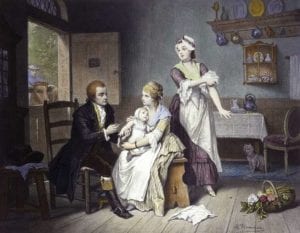
Inoculation by Edward Jenner, 1796
After church Leopold called upon the cathedral dean, Count Leopold Podstatzky, an old acquaintance from Salzburg, who offered lodging for the family. They wrapped the feverish Wolfgang in leather and furs and took him to the deanery, and the next day small red spots appeared; over the next two days the smallpox broke out fully and the fever abated.
Nannerl recalled that Wolfgang could not see for nine days and was disfigured by the disease (though paintings, like Mozart’s 1770 “Verona” portrait, often discreetly overlook the details). She herself caught a milder case and recovered in a few days. On November 10, 1767, Leopold writes from Moravia, “Te Deum Laudamus! Little Wolfgang has got over the smallpox safely!”
Leopold Mozart was no anti-vaxxer but an “anti-inoculist.” He wrote from Paris in 1764, “Here inoculation is the general fashion. But for my part I leave the matter to the grace of God. It depends on His grace whether He wishes to keep this prodigy of nature in this world in which He placed it or to take it to Himself.” In 1768, responding to the disease that cost the lives of three of her children and a daughter-in-law, the enlightened Empress–herself a smallpox survivor–brought a Dutch physician to Vienna to begin inoculation trials. However, “inoculation” (also called “variolation”) with the live virus itself also ran the risk of contracting the potentially fatal disease. Almost thirty years later the Englishman Edward Jenner developed “vaccination” (Latin vaccinus, from cows) from the less virulent cowpox virus, marking the beginning of the eventual end of a viral pandemic that could have cut short the promising musical career of young Wolfgang Mozart.

